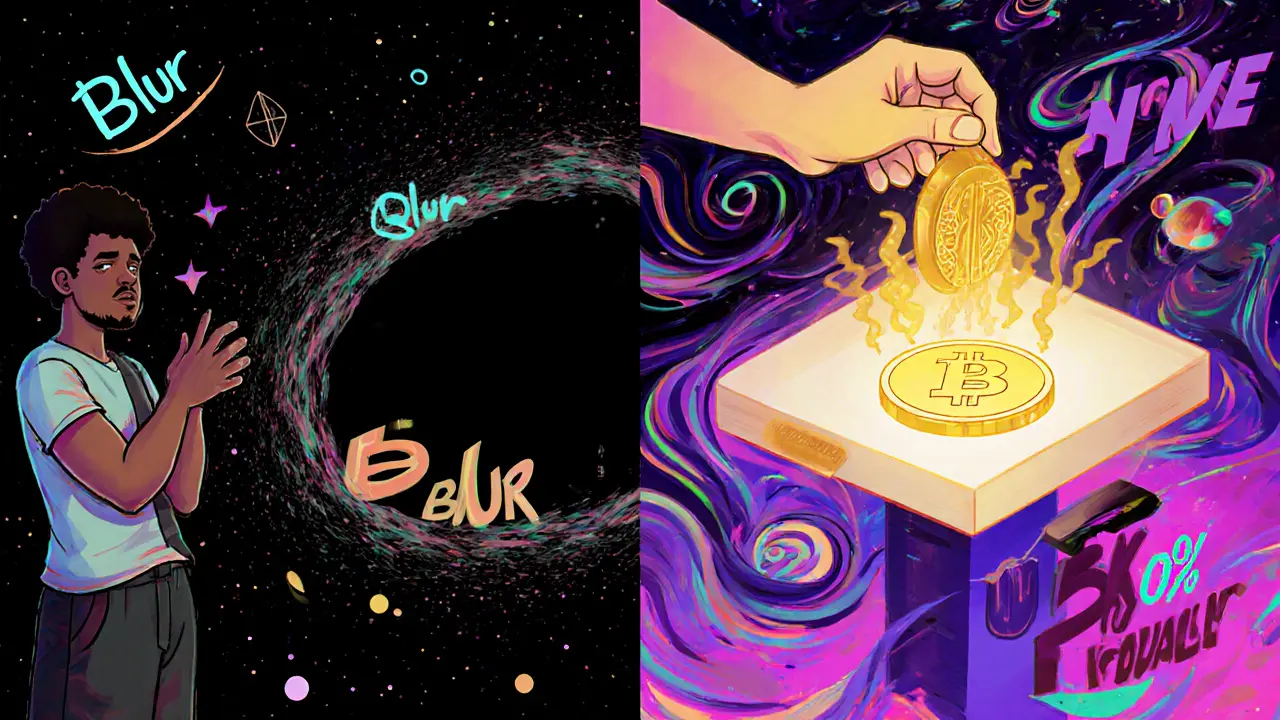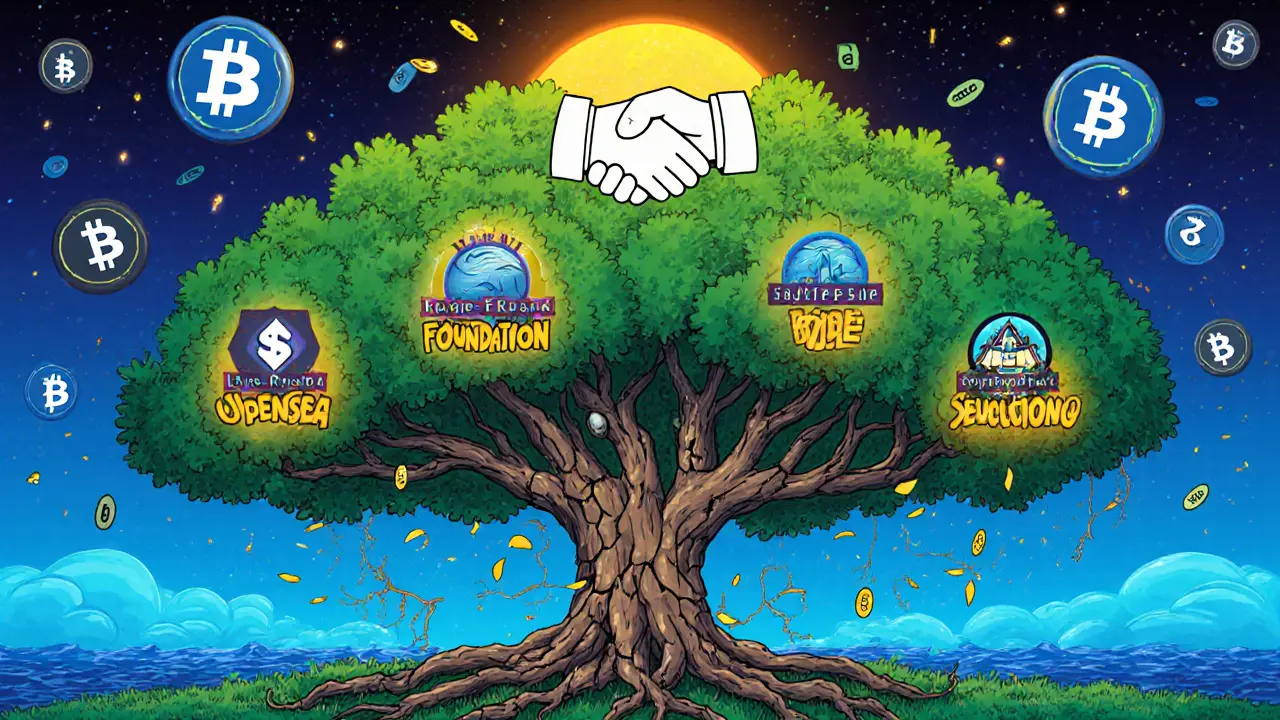How NFT Creators Earn Royalties on Resales
NFT Royalty Calculator
Calculate Your NFT Royalties
Based on INFORMS Journal research: At 7% royalty rate, primary market prices may be 0.8% lower. For rates above 10%, trading volume drops 15.7%. This means your NFT might sell for less upfront when royalties are set higher.
When you buy an NFT, you’re not just buying a digital image or audio file-you’re buying a token that proves you own a unique piece of digital art. But here’s the part most people miss: the original creator still makes money every time that NFT changes hands. That’s not magic. It’s NFT royalties.
How Royalties Actually Work
NFT royalties are built into the smart contract when the NFT is first created. If a creator sets a 7% royalty, then every time that NFT is sold on a supported marketplace, 7% of the sale price automatically goes to the creator’s wallet. No invoices. No follow-ups. No asking nicely. The code handles it.
This system started gaining traction around 2018 with Ethereum’s ERC-721 standard. Platforms like SuperRare and Rarible were the first to build it in. Today, the most common royalty rate is between 5% and 10%. Some creators used to set rates as high as 50%, but the market pushed back. Too high, and buyers won’t resell. Too low, and creators don’t earn enough.
The magic isn’t in the percentage-it’s in the automation. When someone buys an NFT for 3 ETH and the royalty is set at 6%, the smart contract instantly sends 0.18 ETH to the creator’s wallet and 2.82 ETH to the seller. It happens in under 30 seconds on Ethereum. No middleman. No delay. Just code doing what it was told.
Not All Marketplaces Play Fair
Here’s the catch: royalties only work if the marketplace enforces them.
OpenSea used to enforce creator royalties by default. Then, in July 2022, they switched to an opt-in system. Now, creators have to manually enable royalties for each collection-and even then, buyers can still bypass them by trading on other platforms.
Blur, a trading-focused marketplace, made headlines in February 2023 by eliminating royalties entirely. Within months, it captured over half of all Ethereum NFT trading volume. Why? Because traders love zero fees. But creators? They lost millions. One artist on Reddit reported losing $3,200 in expected royalties after her collection was traded on Blur.
Meanwhile, Foundation still enforces 10% royalties on every sale. Magic Eden does too-on Solana. But on Ethereum, enforcement is a mess. Some platforms respect royalties. Others ignore them. And there’s no universal rule forcing them to comply.
This isn’t just inconvenient-it’s a threat to the entire model. If buyers can avoid paying royalties by moving to a non-compliant platform, creators lose their main source of long-term income. And that’s exactly what’s happening.
Why Royalties Matter More Than You Think
For most artists, selling an NFT once doesn’t pay the bills. But royalties? They turn one sale into a lifelong income stream.
Pak’s The Merge collection earned over $91 million in royalties from $918 million in secondary sales. That’s not a fluke. It’s the result of a well-designed system. Artists like Beeple, Grimes, and Fewocious built entire careers on this model. Without royalties, they’d have to rely on constant new drops, which isn’t sustainable.
Royalties also help build trust. Collectors know they’re supporting the artist every time they flip a piece. That creates loyalty. Communities grow. Artists get feedback. The ecosystem thrives.
And it’s not just art. Nike’s .Swoosh platform enforces 10% royalties on virtual sneakers. Gaming NFTs use them to reward developers every time an in-game item is traded. Even musicians are starting to use royalties on audio NFTs.

The Downside: Liquidity and the Royalty Dilemma
But here’s the problem: high royalties can hurt sales.
Research from INFORMS Journal in 2023 found that collections with royalties above 10% saw a 15.7% drop in trading volume. Buyers don’t want to pay extra every time they resell. So they wait. Or they buy on royalty-free platforms. Or they just don’t buy at all.
Another study showed that for every 1% increase in royalty rate, primary market prices dropped by 0.8%. Why? Because buyers factor in future resale costs. If you know you’ll lose 8% every time you flip, you’re not going to pay top dollar upfront.
This is called the ‘royalty dilemma’: creators want higher payouts, but buyers want lower barriers. The sweet spot? Between 3% and 5%. That’s where most successful collections land today.
And even then, enforcement is inconsistent. A 5% royalty on OpenSea means nothing if the same NFT gets sold on Blur for zero royalty. That’s why many creators now push for standardized, blockchain-level enforcement-not just marketplace rules.
What’s Changing in 2025?
The industry is finally starting to fix this.
EIP-2981, a technical standard introduced in 2021, lets NFTs carry royalty information directly in their metadata. That means the royalty isn’t tied to a single marketplace-it travels with the NFT. But adoption has been slow. Only about 42% of new collections use it as of early 2025.
New tools like Royalty Registry and ERC-6672 are trying to fix that. They create a public, blockchain-wide ledger of royalty terms. No more guessing. No more platform dependency.
Some platforms are experimenting with staking models. If you want to trade on a royalty-compliant marketplace, you have to lock up a small amount of crypto as collateral. Break the rules? Lose your stake. It’s not perfect, but it’s a step toward real enforcement.
And legally? The EU is looking at classifying NFT royalties as ‘unfair commercial practices.’ California is considering laws to protect them. That could change everything-if governments step in, marketplaces might have no choice but to comply.

What Creators Should Do Now
If you’re a creator, here’s what you need to do:
- Set your royalty rate between 3% and 7%. Higher than 10% hurts liquidity.
- Use EIP-2981 when minting. It’s the only way to make royalties portable.
- Choose marketplaces that enforce royalties. Foundation, Magic Eden, and SuperRare still do.
- Don’t rely on OpenSea or Blur for royalty income. They’re not safe bets anymore.
- Track your royalties in real time. Platforms like Foundation and Rarible show live dashboards.
And if you’re a collector? Support creators who use fair, enforceable royalties. You’re not just buying art-you’re helping sustain the people who make it.
Will Royalties Survive?
Yes-but only if they become standardized.
Right now, royalties are a patchwork. Some platforms honor them. Others don’t. Some creators earn millions. Others get nothing. That’s not a system. That’s chaos.
The future belongs to creators who use EIP-2981 and sell on platforms that enforce it. It belongs to collectors who refuse to trade on royalty-free marketplaces. And it belongs to developers building tools that make enforcement unavoidable.
NFT royalties were supposed to fix the broken artist economy. They started strong. But without universal rules, they’ll fade into irrelevance.
The choice isn’t between royalties and no royalties. It’s between a fair system and a broken one. And right now, we’re on the edge of that choice.
Do NFT royalties work on all blockchains?
No. Ethereum is the most common, but it doesn’t enforce royalties natively. Solana has its own system, and newer chains like Polygon and Arbitrum have varying levels of support. Royalty enforcement depends on the marketplace and the standard used. EIP-2981 is the closest thing to a universal standard, but even then, it’s only as good as the platform that reads it.
Can I change my royalty rate after minting?
No. Once an NFT is minted, the royalty rate is locked into the smart contract. You can’t change it without creating a new collection. That’s why it’s critical to set the right rate before launch. Most creators test rates with small drops first to see what the market accepts.
Are NFT royalties legally binding?
Not yet. Smart contracts execute code, not laws. Even if a marketplace enforces a 10% royalty, it’s not a court-enforceable contract. Some creators argue they’re protected under copyright law, but no court has ruled on this definitively. That’s why many legal experts call royalties a ‘social contract’-enforced by community norms, not courts.
Why do some NFTs have no royalties at all?
Some creators skip royalties to make their NFTs more attractive to traders. Others use platforms like Blur that don’t enforce them. In competitive markets, especially for PFPs and gaming items, buyers often prefer zero royalties because it means higher profit margins when flipping. It’s a trade-off: lower upfront income for more liquidity.
How much do creators actually earn from royalties?
It varies wildly. Top creators like Pak or Fewocious earn millions. Most average creators make between $500 and $5,000 per year from royalties, depending on collection popularity. According to NFT Plazas’ 2023 survey, 68% of creators received less than 20% of their expected royalty income due to marketplace non-compliance. So while the potential is huge, the reality is often disappointing.
Katherine Wagner
November 15, 2025 AT 12:39Hannah Kleyn
November 17, 2025 AT 05:05Vanshika Bahiya
November 19, 2025 AT 00:44ratheesh chandran
November 20, 2025 AT 02:23Albert Melkonian
November 20, 2025 AT 11:12gary buena
November 20, 2025 AT 13:20Drew Monrad
November 20, 2025 AT 18:26anthony silva
November 21, 2025 AT 15:26Mandy Hunt
November 21, 2025 AT 16:02Kevin Hayes
November 22, 2025 AT 19:05Becky Shea Cafouros
November 24, 2025 AT 08:50sandeep honey
November 24, 2025 AT 23:09Cody Leach
November 26, 2025 AT 08:39